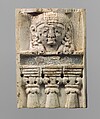Furniture plaque carved in relief with a “woman at the window”
Not on view
During the early first millennium B.C., ivory carving was one of the major luxury arts that flourished throughout the ancient Near East. Elephant tusks were carved into small decorative objects such as cosmetic boxes and plaques used to adorn wooden furniture. Gold foil, paint, and semiprecious stone and glass inlay embellishments enlivened these magnificent works of art. Based on certain stylistic, formal, and technical characteristics also visible in other media, scholars have distinguished several coherent style groups of ivory carving that belong to different regional traditions including Assyrian, Phoenician, North Syrian and South Syrian (the latter also known as Intermediate).
Several ivories in the Metropolitan Museum’s collection are from the Aramaean town of Arslan Tash, ancient Hadatu, in northern Syria just east of the Euphrates River, close to the modern Turkish border. French archaeological excavations at the site in 1928 revealed city walls and gates in addition to a palace and temple that were built when the Neo-Assyrian king Tiglath-Pileser III (744-721 B.C.) turned the town into a provincial capital and military outpost. During the excavations, over one hundred ivory furniture inlays that can be attributed to the South Syrian and Phoenician styles were found in a building near the palace. One piece bears a dedicatory inscription in Aramaic to King Hazael, mentioned in the Bible, who ruled Damascus during the second half of the 9th century (ca. 843-806 B.C.), suggesting that this collection of ivory furniture inlays could have been taken by the Assyrian state as tribute or booty from Damascus. The Arslan Tash ivories share an amalgamation of Egyptianizing motifs typical of the Phoenician style and forms characteristic of North Syrian art that may indicate a South Syrian or Damascene origin of this group. Today, these ivories are housed in museums in Paris, Aleppo, Jerusalem, Karlsruhe, and Hamburg, as well as The Metropolitan Museum of Art.
This plaque is carved in two registers divided by a rectangular band of iridescent glass inlay. It is one of several examples of the “woman at the window” theme from Arslan Tash in which the head of an elaborately adorned female set inside a raised frame looks out toward the viewer from behind a balustrade of columns with volute capitals. The plaque can be attributed to the South Syrian style. Certain details are of Egyptian derivation including the woman’s long curls and originally inlaid, delicately incised eyebrows and eyes, while the large ears, laden with heavy, cruciform earrings, the small mouth and receding chin are characteristic of North Syrian forms. The woman wears a rectangular fringed diadem with pendant tassels or pomegranates. A diadem of this type was found in the grave of one of the royal women in the Neo-Assyrian capital of Nimrud. It is made of gold, and inlaid with lapis lazuli and colored stones. Some scholars associate the “woman in the window” with the Levantine goddess Astarte.
Due to rights restrictions, this image cannot be enlarged, viewed at full screen, or downloaded.

